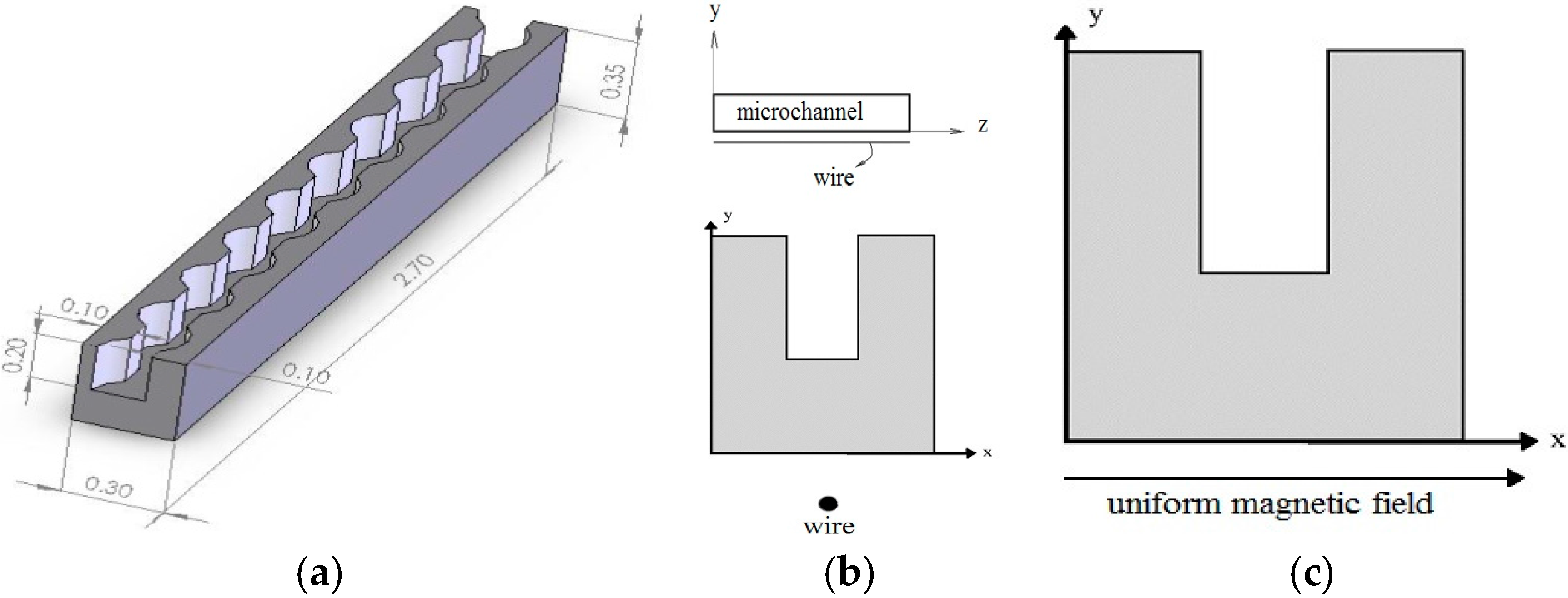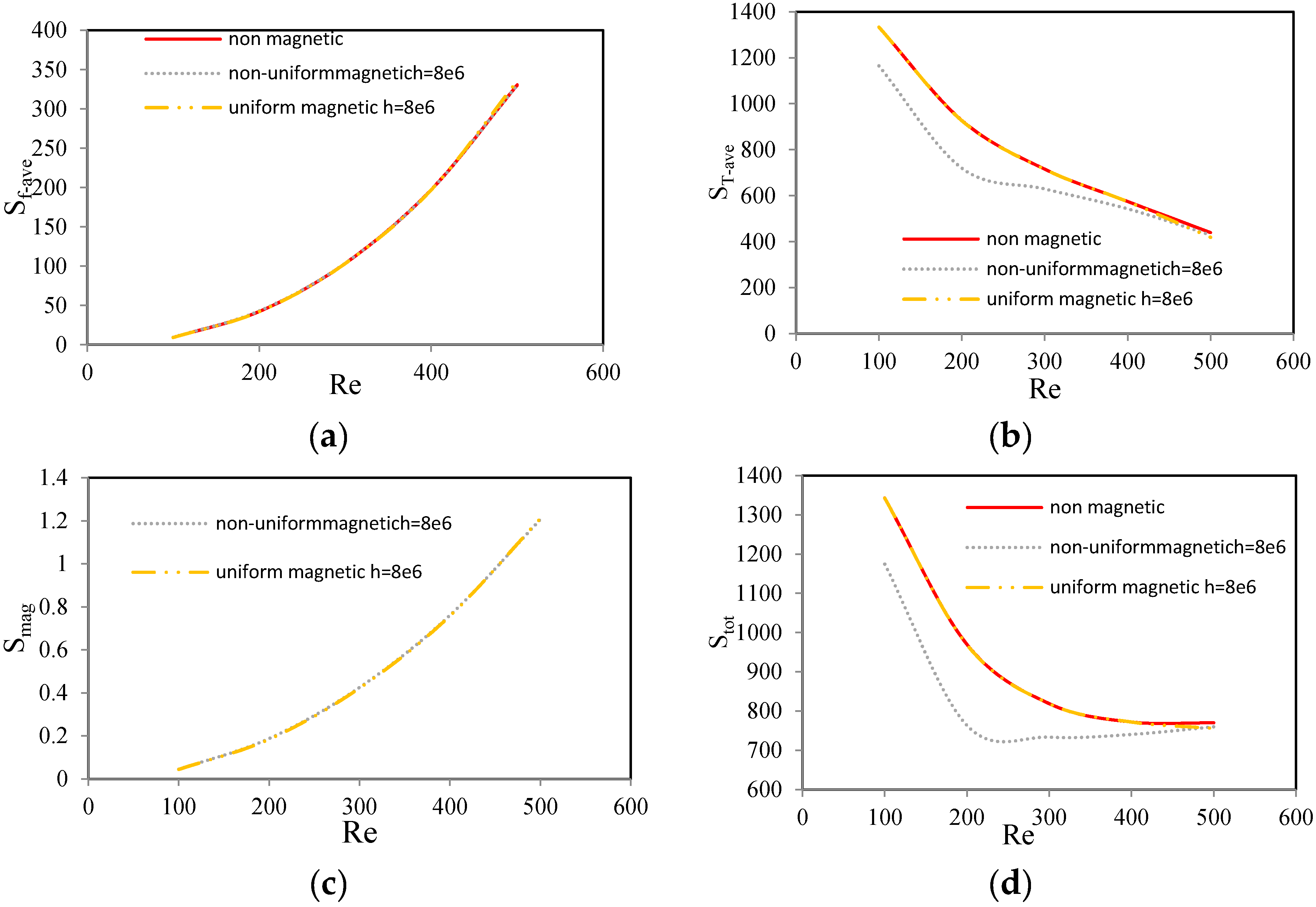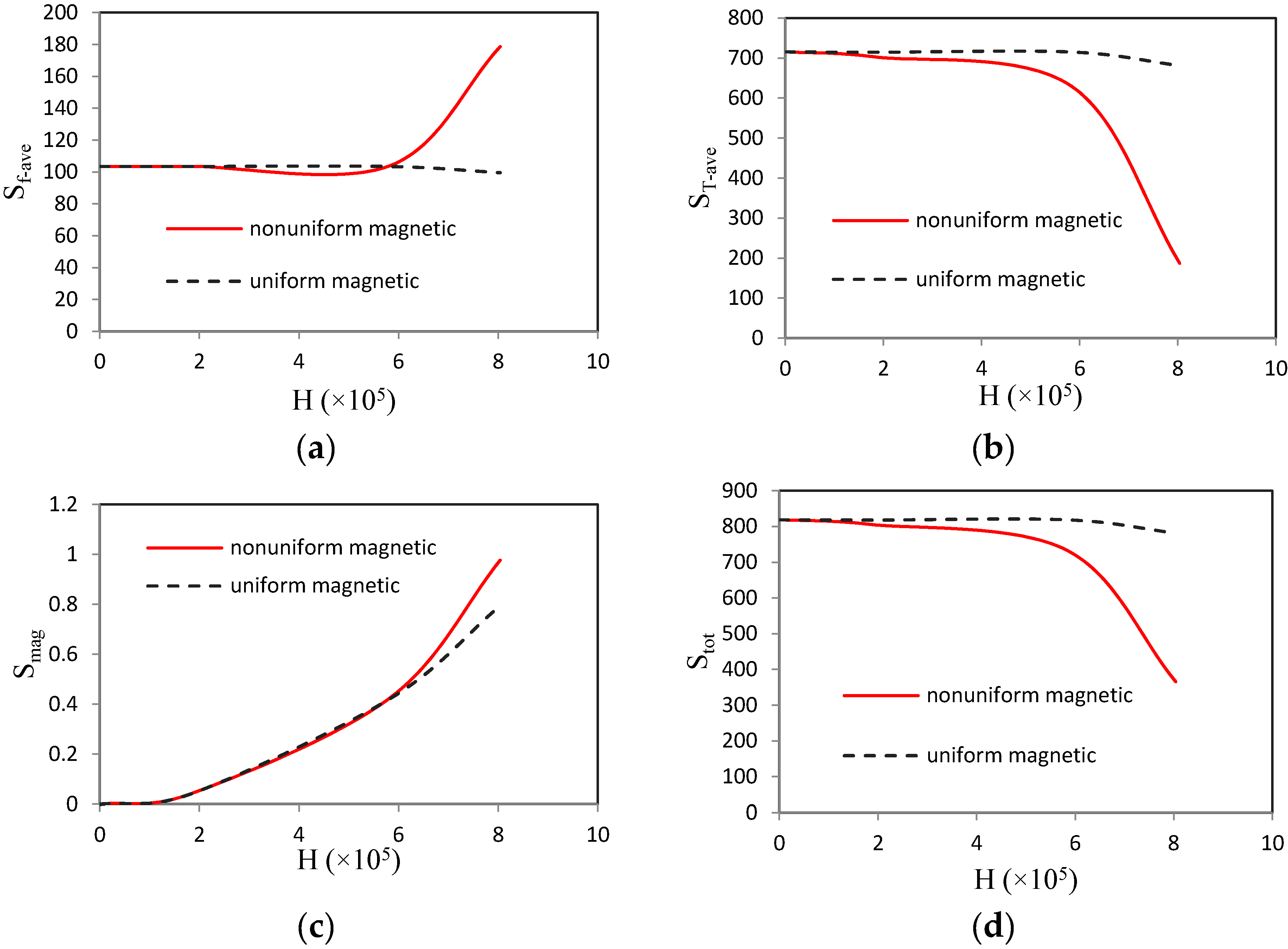Effect of Magnetic Field on Entropy Generation in a Microchannel Heat Sink with Offset Fan Shaped
Abstract
:1. Introduction
2. Governing Equations
3. Nanofluids Properties
| Properties | Water | Fe3O4 |
|---|---|---|
| Density (kg/m3) | 997.1 | 5200 |
| Specific heat capacity (J/kg∙K) | 4180 | 670 |
| Thermal conductivity (W/m∙K) | 0.613 | 6 |
| Electrical conductivity (s/m) | 5.3 | 25,000 |
| Dynamic viscosity (kg/m∙s) | 0.0009963 | - |
4. Definition of Physical Domain

5. Numerical Method
| Grid | T/T0 | V/V0 |
|---|---|---|
| 672914 | 1.027 | 1.038 |
| 889440 | 1.019 | 1.029 |
| 1188000 | 1.013 | 1.023 |
| 1591128 | 1.011 | 1.02 |

| Total Entropy Generation Rate | ||
|---|---|---|
| Vin | Balaji et al. [36] | Present study |
| 2 m/s | 0.0395 | 0.0412 |
| 4 m/s | 0.0295 | 0.0324 |
| 6 m/s | 0.0223 | 0.0242 |
6. Result and Discussion


7. Conclusions
Acknowledgments
Author Contributions
Conflicts of Interest
Abbreviations
| Nomenclature | |
| Cartesian coordinate axes | |
| Velocity component in x and y and z direction, respectively (m/s) | |
| (a,b) | Center of magnetic wire (m) |
| Velocity vector (m/s) | |
| Velocity inlet (m/s) | |
| Acceleration vector (m/s2) | |
| Thermal conductivity (W/m·K) | |
| Specific heat capacity at constant pressure | |
| Boltzmann constant (1.3806503 × 10−23 J/K) | |
| Temperature (K) | |
| I | Electric intensity (A) |
| H | Magnetic field intensity vector (A/m) |
| Heat flux (1 MW/m2) | |
| Channel width (300 × 10−6 m) | |
| Hydraulic diameter (0.00001333 m) | |
| Channel length (2.70 × 10−3 m) | |
| Drag coefficient | |
| Mean velocity (m/s) | |
| Drift velocity (m/s) | |
| Slip velocity (m/s) | |
| d | Mean diameter (m) |
| Sf | Frictional entropy generation |
| ST | Thermal entropy generation |
| Smag | Magnetic entropy generation |
| Reynolds number | |
| Prandtlnumber | |
| Magnetic field (T) | |
| Greek symbols | |
| magnetic permeability in vacuum (4π × 10−7 Tm/A) | |
| Dynamic viscosity (kg/m·s) | |
| Thermal expansion coefficient(thermal expansion coefficient (K−1) | |
| Density (kg/m3) | |
| Mean free path (17 × 10−9 m) | |
| Magnetic susceptibility | |
| Particle volume fraction | |
| Electrical conductivity (s/m) | |
| Subscripts | |
| Particle | |
| Base fluid | |
| Effective | |
| Average | |
References
- Tuckerman, D.B.; Pease, R.F.W. High-Performance Heat Sinking for VLSI. IEEE Electron Device Lett. 1981, 2, 126–129. [Google Scholar] [CrossRef]
- Choi, S.U.S.; Esterman, J.A. Enhancing thermal conductivity of fluids with nanoparticles. Am. Soc. Mech. Eng. 1995, 231, 99–106. [Google Scholar]
- Aminossadati, S.M.; Raisi, A.; Ghasemi, B. Effects of magnetic field on nanofluid forced convection in a partially heated microchannel. Int. J. Non-Linear Mech. 2011, 46, 1373–1382. [Google Scholar] [CrossRef]
- Yang, Y.T.; Lai, F.H. Lattice Boltzmann simulation of heat transfer and fluid flow in a microchannel with nanofluids. Heat Mass Transf. 2011, 47, 1229–1240. [Google Scholar] [CrossRef]
- Lelea, D. The performance evaluation of Al2O3/water nanofluid flow and heat transfer in microchannel heat sink. Int. J. Heat Mass Transf. 2011, 54, 3891–3899. [Google Scholar] [CrossRef]
- Mohammed, H.A.; Gunnasegaran, P.; Shuaib, N.H. The impact of various nanofluid types on triangular microchannels heat sink cooling performance. Int. Commun. Heat Mass Transf. 2011, 38, 767–773. [Google Scholar] [CrossRef]
- Lelea, D.; Nisulescu, C. The micro-tube heat transfer and fluid flow of water based Al2O3 nanofluid with viscous dissipation. Int. Commun. Heat Mass Transf. 2011, 38, 704–710. [Google Scholar] [CrossRef]
- Li, J.; Kleinstreuer, C. Entropy generation analysis for nanofluid flow in microchannels. J. Heat Transf. 2010, 132. [Google Scholar] [CrossRef]
- Mital, M. Analytical analysis of heat transfer and pumping power of laminar nanofluid developing flow in microchannels. Appl. Therm. Eng. 2013, 50, 429–436. [Google Scholar] [CrossRef]
- Nakatsuka, K.; Jeyadevan, B.; Neveu, S.; Koganezawa, H. The Magnetic Fluid for Heat Transfer Applications. J. Magn. Magn. Mater. 2002, 252, 360–362. [Google Scholar] [CrossRef]
- Aminfar, H.; Mohammadpourfard, M.; Narrimanikahnamouei, Y. A 3D numerical-simulation of mixed convection of a magnetic nanofluid in the presence of non-uniformmagnetic field in a vertical tube using two phase mixture model. J. Magn. Magn. Mater. 2011, 323, 1963–1972. [Google Scholar] [CrossRef]
- Aminfar, H.; Mohammadpourfard, M.; Mohseni, F. Two-phase mixture model simulation of the hydro-thermal behavior of an electrical conductive ferrofluid in the presence of magnetic fields. J. Magn Magn. Mater. 2012, 324, 830–842. [Google Scholar] [CrossRef]
- Yang, G.; Wu, J.Y.; Yan, L. Flow reversal and entropy generation due to buoyancy assisted mixed convection in the entrance region of a three dimensional vertical rectangular duct. Int. J. Heat Mass Transf. 2013, 67, 741–751. [Google Scholar] [CrossRef]
- Yilbas, B.S.; Shuja, S.Z.; Gbadebo, S.A.; Al-Hamayle, H.I.A.; Boran, K. Naturalconvection and entropy generation in a square cavity. Int. J. Energy Res. 1998, 22, 1275–1290. [Google Scholar] [CrossRef]
- Erbay, L.B.; Altac, Z.; Sulus, B. An analysis of the entropy generation in a square enclosure. Entropy 2003, 5, 496–505. [Google Scholar] [CrossRef]
- Magherbi, M.; Abbassi, H.; Brahim, A.B. Entropy generation at the onset ofnatural convection. Int. J. Heat Mass Transf. 2003, 46, 3441–3450. [Google Scholar] [CrossRef]
- Jery, A.E.; Hidouri, N.; Magherbi, M.; Brahim, A.B. Effect of an External Oriented Magnetic Field on Entropy Generation in Natural Convection. Entropy 2010, 12, 1391–1417. [Google Scholar] [CrossRef]
- Yazdi, M.H.; Abdullah, S.; Hashim, I.; Sopian, K. Reducing Entropy Generation in MHD Fluid Flow over Open Parallel Microchannels Embedded in a Micropatterned Permeable Surface. Entropy 2013, 15, 4822–4843. [Google Scholar] [CrossRef]
- Yazdi, M.H.; Abdullah, S.; Hashim, I.; Sopian, K. Entropy Generation Analysis of Open Parallel Microchannels Embedded Within a Permeable Continuous Moving Surface: Application to Magnetohydrodynamics (MHD). Entropy 2012, 14, 1–23. [Google Scholar] [CrossRef]
- Abolbashari, M.H.; Freidoonimehr, N.; Nazari, F.; Rashidi, M.M. Entropy Analysis for an Unsteady MHD Flow past a Stretching Permeable Surface in Nanofluid. Powder Tech. 2014, 267, 256–267. [Google Scholar] [CrossRef]
- Rashidi, M.M.; Hosseini, A.; Pop, I.; Kumar, S.; Freidoonimehr, N. Comparative numerical study of single and two-phase models of nanofluid heat transfer in wavy channel. Appl. Math. Mech. 2014, 35, 831–848. [Google Scholar] [CrossRef]
- Rashidi, M.M.; Momoniat, E.; Ferdows, M.; Basiriparsa, A. Lie group solution for free convective flow of a nanofluid past a chemically reacting horizontal plate in a porous media. Math. Probl. Eng. 2014, 2014. [Google Scholar] [CrossRef]
- Garoosi, F.; Rohani, B.; Rashidi, M.M. Two-Phase Mixture Modeling of Mixed Convection of Nanofluids in a Square Cavity with Internal and External Heating. Powder Tech. 2015, 275, 304–321. [Google Scholar] [CrossRef]
- Garoosi, F.; Bagheri, G.; Rashidi, M.M. Two phase simulation of natural convection and mixed convection of the nanofluid in a square cavity. Powder Tech. 2015, 275, 239–256. [Google Scholar] [CrossRef]
- Garoosi, F.; Jahanshaloo, L.; Rashidi, M.M.; Badakhsh, A.; Ali, M.A. Numerical Simulation of Natural Convection of the Nanofluid in Heat Exchangers using a Buongiorno Model. App. Math. Comput. 2015, 254, 183–203. [Google Scholar] [CrossRef]
- Freidoonimehr, N.; Rashidi, M.M.; Mahmud, S. Unsteady MHD free convective flow past a permeable stretching vertical surface in a nanofluid. Int. J. Therm. Sci. 2015, 87, 136–145. [Google Scholar] [CrossRef]
- Akbari, M.; Behzadmehr, A. Developing mixed convection of a nanofluid in a horizontal tube with uniform heat flux. Int. J. Numer. Meth. Heat Fluid Flow 2007, 17, 566–586. [Google Scholar] [CrossRef]
- Akbari, M.; Behzadmehr, A.; Shahraki, F. Fully developed mixed convection in horizontal and inclined tubes with uniform heat flux using nanofluid. Int. Comm. Heat Fluid Flow 2008, 29, 545–556. [Google Scholar] [CrossRef]
- Aminfar, H.; Mohammadpourfard, M.; AhangarZonouzi, S. Numerical study of the ferrofluid flow and heat transfer through a rectangular duct in the presence of a non-uniform transverse magnetic field. J. Magn. .Magn. Mater. 2013, 327, 31–42. [Google Scholar] [CrossRef]
- Tzirtzilakis, E.E.; Kafoussias, N.G. Three-dimensional magnetic fluid boundary layer flow over a linearly stretching sheet. Int. Heat Transf. 2010, 132, 11701–11708. [Google Scholar] [CrossRef]
- Manninen, M.; Taivassalo, V.; Kallio, S. On the Mixture Model for Multiphase Flow; VTT Publications: Espoo, Finland, 1996. [Google Scholar]
- Oztop, H.F.; Abu-Nada, E. Numerical study of natural convection in partially heated rectangular enclosures filled with nanofluids. Int. J. Heat Fluid Flow 2008, 29, 1326–1336. [Google Scholar] [CrossRef]
- Brinkman, H.C. The viscosity of concentrated suspensions and solutions. J. Chem. Phys. 1952, 20, 571–582. [Google Scholar] [CrossRef]
- Chon, C.H.; Kihm, K.D.; Lee, S.P.; Choi, S.U.S. Empirical correlation finding the role of temperature and particle size for nanofluid (Al2O3) thermal conductivity enhancement. Appl. Phys. Lett. 2005, 87, 1–3. [Google Scholar] [CrossRef]
- Chai, L.; Xia, G.; Zhou, M.; Li, J. Numerical simulation of fluid flow and heat transfer in a microchannel heat sink with offset fan-shaped reentrant cavities in sidewall. Int. Commun. Heat Mass Transf. 2011, 38, 577–584. [Google Scholar] [CrossRef]
- Balaji, C.; Hölling, M.; Herwig, H. Entropy generation minimization in turbulent mixed convection flows. Int. Commun. Heat Mass Transf. 2007, 34, 544–552. [Google Scholar] [CrossRef]
- Bejan, A. Entropy Generation through Heat and Fluid Flow; Wiley: New York, NY, USA, 1982. [Google Scholar]
© 2015 by the authors; licensee MDPI, Basel, Switzerland. This article is an open access article distributed under the terms and conditions of the Creative Commons by Attribution (CC-BY) license (http://creativecommons.org/licenses/by/4.0/).
Share and Cite
Nasiri, M.; Rashidi, M.M.; Lorenzini, G. Effect of Magnetic Field on Entropy Generation in a Microchannel Heat Sink with Offset Fan Shaped. Entropy 2016, 18, 10. https://doi.org/10.3390/e18010010
Nasiri M, Rashidi MM, Lorenzini G. Effect of Magnetic Field on Entropy Generation in a Microchannel Heat Sink with Offset Fan Shaped. Entropy. 2016; 18(1):10. https://doi.org/10.3390/e18010010
Chicago/Turabian StyleNasiri, Mohammad, Mohammad Mehdi Rashidi, and Giulio Lorenzini. 2016. "Effect of Magnetic Field on Entropy Generation in a Microchannel Heat Sink with Offset Fan Shaped" Entropy 18, no. 1: 10. https://doi.org/10.3390/e18010010






